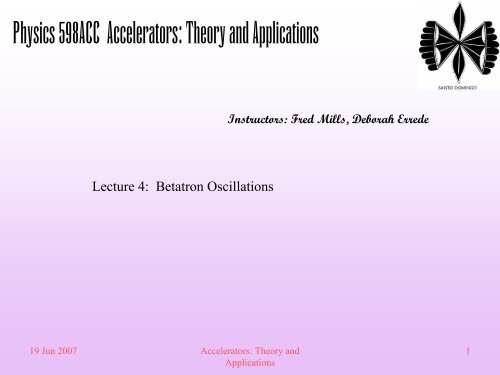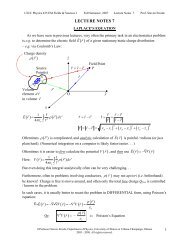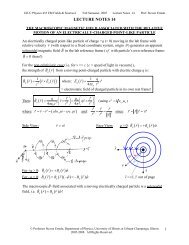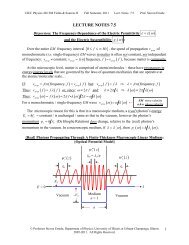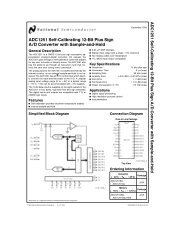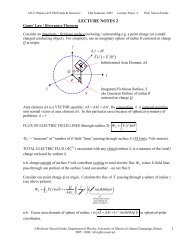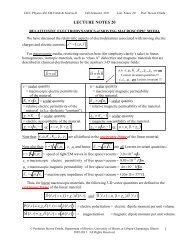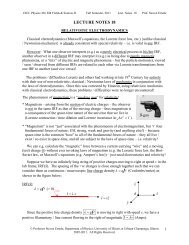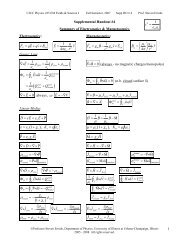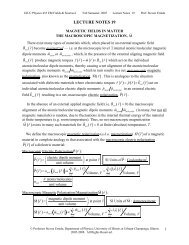Betatron Oscillations
Betatron Oscillations
Betatron Oscillations
Create successful ePaper yourself
Turn your PDF publications into a flip-book with our unique Google optimized e-Paper software.
Physics 598ACC Accelerators: Theory and Applications<br />
Instructors: Fred Mills, Deborah Errede<br />
Lecture 4: <strong>Betatron</strong> <strong>Oscillations</strong><br />
19 Jun 2007 Accelerators: Theory and<br />
Applications<br />
1
Summary<br />
A. Mathieu-Hill equation<br />
B. Transfer matrix – properties<br />
C. Floquet theory solutions<br />
D. CSL invariant and emittance<br />
19 Jun 2007 Accelerators: Theory and<br />
Applications<br />
2
<strong>Betatron</strong> <strong>Oscillations</strong><br />
(see “Theory of the Alternating-Gradient Synchrotron”, E.D. Courant and H.S. Snyder)<br />
The equations of motion for betatron oscillations were found to be of the type<br />
4.1<br />
y ′ + Ks ( )y = 0<br />
where K(s) is a periodic function with period C = 2πR, or higher periodicity if the<br />
accelerator "lattice" has higher periodicity, as will usually be the case. In terms of the<br />
magnetic field, its gradient and the "magnetic rigidity” Bρ = P 0c<br />
, K = B 2<br />
⎛<br />
⎜ 0<br />
⎞<br />
⎟<br />
B ′<br />
+<br />
e ⎝ Βρ⎠<br />
Bρ<br />
for the horizontal plane, and K =− B ′ for the vertical plane.<br />
Bρ<br />
Then 4.1 is a Mathieu-Hill equation for y, and Floquet's theorem applies to the<br />
solutions, that is that the two linearly independent solutions can be written in the form<br />
exp[±iψ(s)]w(s), where w(s) is a periodic function of s. We will use this fact later, but<br />
first let us look at some general properties of the solutions.<br />
19 Jun 2007 Accelerators: Theory and<br />
Applications<br />
note<br />
B<br />
'<br />
∂B<br />
= ∂ x<br />
z<br />
3
Let N be the number of periods per revolution, and<br />
be the length of one period.<br />
Since the y equation is linear, the solutions at two points s and s 0 are linearly related. If<br />
Y is the column vector we can write<br />
4.2<br />
⎡ y ⎤<br />
⎢<br />
⎣ y ′ ⎥<br />
⎦<br />
Y()= s M s| s 0<br />
( )Ys 0<br />
( )<br />
L= C N<br />
( ) M( s 2<br />
s 1 )<br />
where M s 2<br />
s 1 is a 2x2 matrix . The determinant of is unity, since the<br />
*<br />
Wronskian determinant is constant because the coefficient of y' is zero in 4.1. We note<br />
that the transformations M form a group, since the identity Μ( s|s)= I exists, the<br />
inverse M −1 ( s | s 0 )= M( s 0<br />
| s) exists because det Μ ≠ 0 , and M( s| s 0 )= M( s| s 1 )M ( s 1<br />
| s 0 ).<br />
Some useful examples of M are when K is constant. For K=0 (drift),<br />
4.3<br />
M( ⎡<br />
s| s 0 )= 1 s− s ⎤<br />
0<br />
⎢<br />
⎣ 0 1 ⎥<br />
⎦<br />
19 Jun 2007 Accelerators: Theory and<br />
Applications<br />
*see notes<br />
4
Wronskians: (see, for example, Morse and Feshbach p. 524)<br />
for a differential equation of the form<br />
" '<br />
y + f(x)y + g(x)y=<br />
0<br />
y y<br />
W(y ,y ) = = y y −y y<br />
1 2 ' '<br />
1 2 ' ' 1 2 2 1<br />
y1 y2<br />
(y 1 ,y 2 solutions to the eqn above)<br />
for f(x), g(x) continuous on an open interval I, two solutions y 1 , y 2 are linearly<br />
independent if their Wronskian W is nonzero for any range of x in I.<br />
Also Abel’s Theorem states that for the above differential eqn the Wronskian of the two<br />
solutions is<br />
−∫f (z)dz<br />
W(y ,y )(x) = W(y ,y )(x )e = ce<br />
1 2 1 2 0<br />
note that if f(x)=0, the Wronskian is constant. (canonical Poisson brackets = 1, and components of the<br />
brackets almost correspond to the elements of the matrix M. The Poisson bracket is the determinant of M)<br />
x<br />
−<br />
0 0<br />
x<br />
∫<br />
f (z)dz<br />
19 Jun 2007 Accelerators: Theory and<br />
Applications<br />
5
When K is positive (F or focusing),<br />
4.4<br />
M( s| s 0 )=<br />
⎡<br />
cosφ<br />
⎢<br />
⎢<br />
⎣ − Ksinφ<br />
sinφ ⎤<br />
K<br />
⎥<br />
⎥<br />
cosφ⎦<br />
while if K is negative (D or defocusing),<br />
4.5<br />
M( s| s 0 )=<br />
⎡<br />
⎢<br />
⎢<br />
⎣<br />
coshψ<br />
-Ksinhψ<br />
sinhψ ⎤<br />
⎥<br />
-K<br />
⎥<br />
coshψ⎦<br />
( ) ψ= -K( s − s ) 0<br />
Here φ= K s − s 0 , and .<br />
19 Jun 2007 Accelerators: Theory and<br />
Applications<br />
6
Now let us define the matrix for one period<br />
4.6<br />
⎡a<br />
b⎤<br />
M(s + L | s ) = M(<br />
s)<br />
= ⎢<br />
c d ⎥<br />
⎣ ⎦<br />
The matrix for one revolution is Μ N ( s) , and for k revolutions is Μ kN ( s)<br />
. The motion<br />
will remain bounded if the matrix elements remain bounded as kN-> ∞. Consider the<br />
eigenvalues λ of M<br />
4.7 Μ Y =λY<br />
Solutions exist if<br />
4.8<br />
The equation for λ becomes<br />
4.9<br />
det Μ − λI = 0<br />
λ 2 −λ( a + d)+ 1 = 0<br />
19 Jun 2007 Accelerators: Theory and<br />
Applications<br />
7
Let<br />
4.10 cosμ = 1 2 Tr M = a + d<br />
2<br />
The two solutions of 4.8 become<br />
µ is real if<br />
4.12<br />
λ=cosμ ± isinμ<br />
4.11 *see homework<br />
a + d ≤ 2<br />
Now define α, β, and γ in the following way;<br />
a − d = 2αsinμ<br />
4.13 b =βsinμ<br />
c =−γsinμ<br />
det Μ =1<br />
implies that<br />
4.14<br />
γ = 1+α 2<br />
β<br />
19 Jun 2007 Accelerators: Theory and<br />
Applications<br />
8
for transfer matrix on p.10<br />
cosμ=<br />
αsin<br />
μ=<br />
a+<br />
d<br />
2<br />
a−<br />
d<br />
2<br />
b and c are given in 4.13.<br />
a+ d a−d<br />
a = + = cosμ+αsinμ<br />
2 2<br />
d= cosμ−αsinμ<br />
19 Jun 2007 Accelerators: Theory and<br />
Applications<br />
9
The transfer matrix is now<br />
* see notes p.9<br />
4.15<br />
⎡<br />
Μ()= s<br />
a b ⎤<br />
⎣<br />
⎢ c d⎦<br />
⎥<br />
⎡ cosμ + αsinμ<br />
= βsinμ<br />
⎣ ⎢ −γsinμ<br />
⎤<br />
cosμ - αsinμ⎦<br />
⎥ = I cosμ+Jsinμ<br />
⎡<br />
4.16 J = α β ⎤<br />
,<br />
⎣ ⎢ −γ −α⎦<br />
⎥ det J =1<br />
4.17<br />
M Nk = ( Icosμ +Jsinμ) Nk = IcosNkμ +JsinNkμ<br />
Then if µ is real, the matrix elements of M Nk remain bounded, and the motion is stable.<br />
We note that M()= 0 I,<br />
4.19<br />
M −1 ()= μ M( -μ),<br />
M( μ 1<br />
+μ 2 )= M( μ 1 )M( μ 2 )<br />
19 Jun 2007 Accelerators: Theory and<br />
Applications<br />
10
The definition of µ does not depend on the point s where the matrix is defined, for, if<br />
we calculate the matrix between s 1 and s 2 +L, first by going from s 1 to s 2 , then by going<br />
from s 2 to s 2 +L, if M s 2<br />
s 1 is the matrix connecting s 1 and s 2 ,<br />
while if we first go from s 1 to s 1 +L, and then from s 1 +L to s 2 +L,<br />
Then<br />
4.20<br />
4.21<br />
( )<br />
M( s 2<br />
+ Ls 1 )= M( s 2<br />
)M( s 2<br />
s 1 )<br />
( ) ( )<br />
(see definition 4.6)<br />
M(s + L | s) = M s + L| s + L M s = M(s | s) M(s)<br />
2 1 2 1 1 2 1 1<br />
M( s 2<br />
)= M( s 2<br />
s 1 )M( s 1<br />
)M −1 s 2<br />
s 1<br />
( )<br />
Thus the two matrices are related by a similarity transformation. Thus if M(s )Y = λY<br />
,<br />
M<br />
' '<br />
(s<br />
2)Y =λY<br />
( ) ′<br />
also, where Y = M −1 s 2<br />
s 1<br />
Y . If det M( s 2<br />
)−λI = 0 then det M( s 1<br />
)− λI = 0<br />
also, and the two matrices have the same eigenvalues, hence the same value of µ.<br />
1<br />
19 Jun 2007 Accelerators: Theory and<br />
Applications<br />
11
Modern accelerators have lattices which are composed of successive regions of<br />
constant values of K (which might include curvature). The matrix for each region is<br />
one of the forms 4.3 to 4.5. Then we can find the one period matrix M(s) by matrix<br />
multiplication, and find µ from the trace of that matrix, and α, β, γ by using 4.13. On<br />
the other hand, to find α, β, γ at every point in the lattice by this method is tedious and<br />
time consuming. We will develop better means to calculate these functions, but first we<br />
need to learn more about them.<br />
Let us attempt a solution to 4.1 in the phase-amplitude form<br />
4.22<br />
where w and ψ are real, and w is periodic. Then<br />
4.23 y ′ + Ky = [ w ′ ± i2 ( w ′ ψ ′ + w ψ ′ )− w ( ψ ′) 2 + Kw]exp( iψ)= 0<br />
The exponent is not zero, in general, so both the real and imaginary parts of the bracket<br />
must vanish.<br />
y = ws ()exp[±iψ( s)]<br />
19 Jun 2007 Accelerators: Theory and<br />
Applications<br />
12
For the imaginary part,<br />
( ) ′ = 0 ′<br />
4.24 w 2 ψ ′ , or<br />
ψ = 1 w 2<br />
where we have taken the arbitrary constant of integration to be 1 by absorbing it into the<br />
definition of w. For the real part,<br />
w ′′<br />
+ Kw − 1 = 0<br />
w 3<br />
4.25 (using 4.24)<br />
We are now in a position to express M in terms of w and ψ. Any solution can be<br />
written as a linear combination of the two linearly independent solutions<br />
4.26<br />
y = Awcosψ + Bwsinψ<br />
⎛<br />
y ′ = A w ′ cosψ− sinψ ⎞<br />
⎝ w ⎠ + B ⎛<br />
w ′ sinψ+cosψ ⎞<br />
⎝ w ⎠<br />
19 Jun 2007 Accelerators: Theory and<br />
Applications<br />
13
We can evaluate A and B at s 1 , let ψ=0, y=y 1 , and y ' =y 1‘ . Then A = y 1<br />
,<br />
and B = w 1<br />
y ′ 1<br />
− w ′ 1<br />
y 1<br />
. Introduce the values of A and B into 4.26 and<br />
collect coefficients of y 1 and y 1<br />
'<br />
to find<br />
4.27<br />
M( s 2<br />
s 1 )=<br />
⎡<br />
⎢<br />
⎢ ⎛<br />
cosψ⎜<br />
⎣<br />
⎢ ⎝<br />
w ′ 2<br />
−<br />
w 1<br />
cosψ w 2<br />
− w 2<br />
w 1<br />
′ sinψ<br />
w 1<br />
w 1<br />
′<br />
w 2<br />
⎞<br />
⎟ − sinψ<br />
⎠<br />
w 1<br />
⎤<br />
w 1<br />
w 2<br />
sinψ<br />
⎥<br />
⎛<br />
⎜<br />
1 ⎞<br />
+ w 1<br />
′ w ′ 2<br />
⎟ cosψ w 1<br />
⎥<br />
+ sinψ w 1<br />
′ w<br />
2′<br />
⎝ w 1<br />
w 2<br />
⎠ w 2<br />
⎥<br />
⎦<br />
Now we evaluate M in the case s 2 = s 1 +L, and require w 1 = w 2 = w<br />
4.28<br />
M( s 2<br />
)=<br />
⎡ cosψ − w w ′ sinψ w 2 sinψ ⎤<br />
⎢<br />
− ⎛ 1 ⎝ w + ( w ′ ⎞<br />
2 )2<br />
⎠<br />
sinψ cosψ+w w ′<br />
⎣<br />
sinψ ⎥<br />
⎦<br />
19 Jun 2007 Accelerators: Theory and<br />
Applications<br />
14
Now we compare 4.28 with 4.15, and we can find the following relations<br />
4.29<br />
w 2 = β<br />
w w ′ =−α<br />
α=− β ′<br />
2<br />
μ=ψ( s + Ls)−ψs<br />
()=<br />
α ′ = Kβ−γ<br />
1<br />
γ= +<br />
2<br />
w<br />
s + L<br />
∫<br />
s<br />
ds<br />
β<br />
'<br />
( w ) 2<br />
s+<br />
L<br />
= ∫<br />
s<br />
dψ<br />
ds<br />
ds<br />
(see 4.24)<br />
(use 4.25)<br />
The last equation follows from 4.25 and the relations between w, α, and β. Another<br />
useful differential relationship exists for γ, although α, β, and γ are related by 4.14,<br />
4.30<br />
γ ′ =2Kα<br />
19 Jun 2007 Accelerators: Theory and<br />
Applications<br />
15
We can now use 4.29 and 4.30 in 4.27 to find a general transfer matrix between any<br />
two points 1 and 2 in the lattice,<br />
4.31<br />
⎡<br />
⎢<br />
M( s 2<br />
s 1 )= ⎢<br />
⎢<br />
⎣<br />
β 2<br />
β 1<br />
( cosψ +α 1<br />
sinψ ) β 1<br />
β 2<br />
sinψ<br />
⎛<br />
cosψ α 1<br />
−α 2<br />
⎞ ⎛<br />
⎜ ⎟ − sinψ 1+α 1α 2<br />
⎞<br />
⎜ ⎟<br />
⎝ β 1<br />
β 2 ⎠ ⎝ β 1<br />
β 2 ⎠<br />
β 1<br />
β 2<br />
⎤<br />
⎥<br />
⎥<br />
( cosψ−α 2<br />
sinψ)<br />
⎥<br />
⎦<br />
We will use these differential relationships together with matrix properties to solve for<br />
lattice parameters. First we wish to define an important quantity, ν, which is related to<br />
the phase advance µ, but is a property of the whole accelerator.<br />
4.32<br />
ν= Nμ<br />
2π =<br />
19 Jun 2007 Accelerators: Theory and<br />
Applications<br />
∫<br />
s<br />
s+ C<br />
ds<br />
2πβ<br />
ν is the total number of<br />
betatron oscillations in one<br />
revolution (in the y coordinate).<br />
see 4.29<br />
16
We can also find a constant of the linear motion, W,<br />
called the CSL (Courant, Livingston, and Snyder) invariant.<br />
Any solution can be written, by virtue of 4.29,<br />
4.33<br />
y= Wβcos( ψ+δ)<br />
W<br />
β<br />
[ ]<br />
'<br />
y = sin( ψ+δ) −αcos( ψ+δ)<br />
where W and δ are constants. Solving for cos and sin, squaring and adding,<br />
4.34 W = y2 +β′ ( y +αy) 2<br />
β<br />
=γy 2 + 2αy y ′ +β y ′<br />
2<br />
19 Jun 2007 Accelerators: Theory and<br />
Applications<br />
17
This is the equation of an ellipse of area πW in y,y ' space. The ellipse is upright when<br />
α = 0 and tilted otherwise. The maximum value of y at a given point in the lattice is<br />
βW<br />
because of 4.33. If βW is the maximum amplitude of betatron oscillation<br />
of particles in a beam, then the beam "emittance", which is the area enclosing all the<br />
beam particles, is πW. Note that πWP is the projected area of the orbit in phase space,<br />
and will tend to remain constant as the particles are accelerated (adiabatic invariant).<br />
19 Jun 2007 Accelerators: Theory and<br />
Applications<br />
18
End of Lecture<br />
19 Jun 2007 Accelerators: Theory and<br />
Applications<br />
19
19 Jun 2007 Accelerators: Theory and<br />
Applications<br />
20


